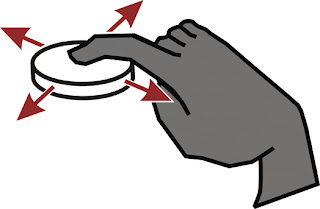The romantic idea of pulling a large, foldout map from your bag and using it to navigate your way through an unknown city has become virtually obsolete, especially since the creation of Google maps and its proliferation among smart phones.
But how would you find your way to a “point of interest” if you were blind? You could use your fingers – one day.
William Provancher, 38, an assistant professor of mechanical engineering at the University of Utah, developed a technology based on haptics – the sense of touch – that in a couple of years might help blind people find their way to a favorite coffee shop.
Video games already use tactile cues such as “rumble” to give the player a more realistic experience when crashing a virtual go-cart into a wall. And cell phones have been using vibration as an alternative to sound for years.
But Provancher has taken the use of haptics to another level.
“What our device can do is give you direction cues,” he said.
The technology would allow users to place their fingertip on top of a small button about the size of a pea, and receive direction cues through skin stretch.
In the study that took about two and a half years to conduct, Provancher found, “people are very good at perceiving small amounts of skin stretch,” he said.
The device gives cues by stretching the skin slightly in both horizontal and vertical directions (left, right, front, back).
Blind people already benefit from voice recognition software that can be programmed into cell phones, allowing the user to hear directions as opposed to reading them.
In the future, blind people may be able to use their canes or cell phones to guide them via touch-based navigation.
Joan Rushing, 56, program director at the Chicago Lighthouse, an organization that provides services for blind people, thinks that Provancher’s new technology could be a step forward.
“As long as there is no display read-out, and it can get you there by feel/touch, then I think we’re headed in the right direction,” she said.
The technology Provancher has developed is currently ready to be installed into the steering wheel of a car – as another way to receive navigation cues when a person can’t hear the GPS for example – but Provancher is looking at how the technology could be used to help people with impaired vision. And he is focusing on making the technology available in a mobile and compact manner – something that would please Ray Campbell, 45, an adaptive technology specialist at the Chicago Lighthouse, and who is also blind.
“Put it in something that I already have – and that’s the cell phone – and I’ll be happy,” Campbell said.
Thursday, October 7, 2010
New system may allow blind people to navigate by touch
From Medill Reports at Northwestern Univ. in Chicago:

